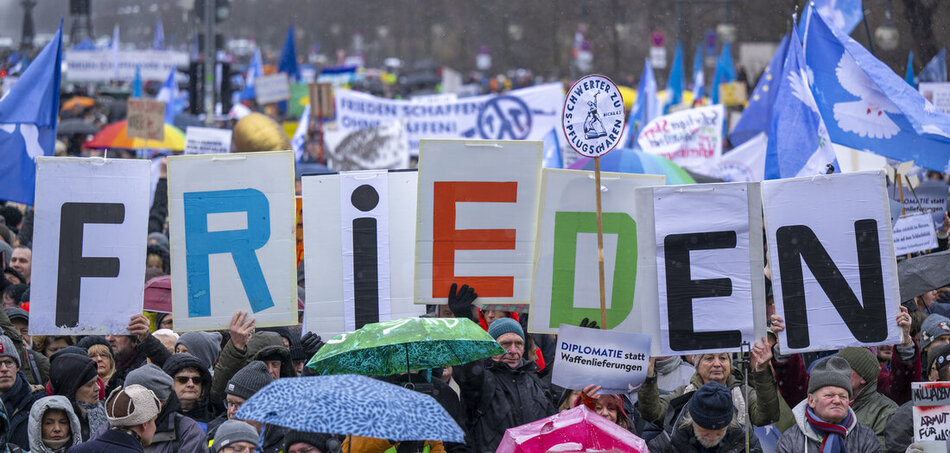

‘Peace,’ reads banner in Berlin protest of Ukraine war, Feb. 25, 2023.
In the week of the first anniversary of the U.S./NATO proxy war against Russia in Ukraine, the Biden administration has taken or announced steps to prolong that war and risk its escalation. The corporate media has parroted and amplified every government announcement. And the antiwar movement began to respond.


‘Peace,’ reads banner in Berlin protest of Ukraine war, Feb. 25, 2023.
President Joe Biden made a quick trip Feb. 20 by rail into Kiev, where he met Ukrainian President Vlodymyr Zelensky to prop up his shaky regime. Biden offered the U.S. puppet $500 million in arms and ammunition.
Quickly back by rail to Warsaw, Poland, Biden told reporters at the Royal Castle that there would be “hard and bitter days ahead,” and before returning to Washington, he promised that Washington and its NATO allies would “have Ukraine’s back,” which implies more Ukrainians will die at the front. (PBS, Feb. 21)
On Feb. 24, the Pentagon announced a new aid package for Ukraine, committing $2 billion to send more rounds of ammunition and a variety of small, high-tech drones into the slaughter. The aid includes the upgraded Switchblade 600 Kamikaze drone, as well as electronic warfare detection equipment. The U.S. has now committed more than $32 billion in weapons in the past year, according to an AP report.
Propaganda offensive
Washington also opened a diplomatic and propaganda offensive. An anti-Russia vote in the United Nations General Assembly had more or less the same results as similar calls last year. While 141 countries voted to condemn, including the historic colonialist countries in Europe, North America, Japan and Australia, the 39 countries voting against or abstaining included those with the largest populations.
When the Chinese government proposed a perfectly reasonable framework for negotiations, Washington responded as if Beijing’s proposal were a declaration of war. (tinyurl.com/5bazbzdj) Biden immediately dismissed it. His reaction sent the message that the U.S./NATO side wanted the proxy war in Ukraine to continue.
A virtual Niagara Falls of lies from the governments and corporate media then bombarded the populations in the imperialist countries. Up to now, the governments — including all NATO members — have aligned with the U.S.’ pro-war line. While this deluge of propaganda blunted the response of organizations and parties that are usually antiwar — the Left Party in Germany, for example — there were indications within the working class of a growing distrust of the U.S./NATO official arguments. The closer to the front line, the greater the worry about the war.
Antiwar actions
Pro-war forces exploited the one-year anniversary to organize support for the war. Antiwar actions in most countries were stronger than they had been.
In Germany, a key supporter of the U.S./NATO war, the first mass antiwar demonstrations under left leadership hit the streets. Tens of thousands of Germans attended the Uprising for Peace mass rally in Berlin Feb. 25. The rally’s main spokespeople were Die Linke (Left Party) politician Sahra Wagenknecht and author Alice Schwarzer.
The Left Party has serious divisions regarding the war in Ukraine, which has held back the antiwar movement up to now.
The demonstrators called upon the Social Democratic-led coalition government in Berlin to stop supplying the Kiev regime with weapons, and they demanded peace talks. As Wagenknecht remarked, the rally showed “how many we are” and that we needed a new, strong peace movement, and “we’re getting ourselves organized.” (junge Welt, Feb. 27)
Veteran journalist Seymour Hersh’s article, revealing the U.S. role in setting bombs to destroy parts of the Nord Stream pipelines carrying Russian gas to Germany, exposed the terrorist tactics Washington employs to keep its European Union allies in line, regarding the economic offensive against Russia. (tinyurl.com/bdhn647j)
In Italy, thousands of people demonstrated across the country in Rome, Florence, Milan and Genoa, against Western sanctions imposed on Russia. The protesters demanded that Italian Prime Minister Giorgia Meloni’s government stop supplying Kiev with weapons.
Milan, Feb. 25, 2023, one of many actions across Italy opposing arms deliveries to Kiev. (Photo Credit: Fronte Popolare)
The U.S. has used its Camp Darby base near Livorno as a major depot for weapons and its air base at Aviano, in Italy’s northeast, to bomb Yugoslavia in 1999 and Libya in 2011. From Italian soil, many U.S. air bases threaten Russia with a possible nuclear first strike. These threats also make Italy a target.
Demonstrations also took place in various cities of Portugal and smaller actions in Britain.
As important as these antiwar protests were, an even greater sign of working-class resistance has been the growing number of major strike actions in Germany, Italy, Spain, Portugal and especially in Britain and France. These are a response to the decades of encroachments on workers’ standards of living and the special sacrifices demanded by a war that is not in the interest of the workers.
Protest planned in the U.S.
In the United States, too, workers have been in motion for the past two years, much more so than previously, with young workers questioning government policies on all fronts. And the antiwar movement has called for national actions on March 18, with the central action at 1 p.m. at the White House in Washington.
This action unites all forces on the left that have been agitating for an end to NATO’s aggression in Europe and worldwide and battling the U.S. use of economic sanctions — another form of war. (unacpeace.org)
Hamas issued the following statement on April 24, 2025, published on Resistance News Network. The…
By D. Musa Springer This statement is from Hood Communist editor and organizer D. Musa…
Portland, Oregon On April 12 — following protests in Seattle and elsewhere in support of…
This statement was recently issued by over 30 groups. On Friday, March 28, Dr. Helyeh…
When Donald Trump announced massive tariffs on foreign imports April 2, Wall Street investors saw…
The century-long struggle to abolish the death penalty in the U.S. has been making significant…